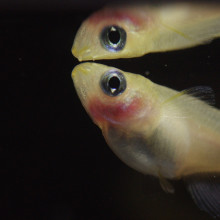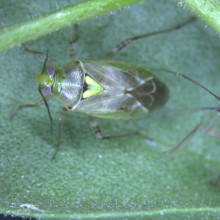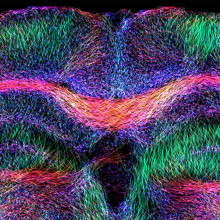eLife Episode 41: Fish Recognise Faces
In this episode of the eLife Podcast biomarkers for epilepsy, how fish can recognise faces, insect anti-anti aphrodisiacs, and why striving for novelty may hinder the progress of science.
In this episode

00:34 - Fishing for clues: fish recognise fish faces
Fishing for clues: fish recognise fish faces
with Mu-Yun Wang, University of Tokyo
Fish are social creatures capable of learning from one another and some species also have a hierarchy; so it figures that they should be able to recognise one another’s faces… Chris Smith hears how from the University of Tokyo's Mu-Yun Wang...
Mu-Yun: So medaka fish is only about 2 or 3 centimetres long and they live in the rice field in East Asia and they are very popular pets in Japan; so almost all the Japanese kids will have them as pets. Recently, they’ve become very popular molecular models. So we have a good number of molecular toolsets to edit their genome and they're also very good for studying neuroscience. That’s why we are interested in this small fish.
Chris: In particular, what were you interested in studying this time?
Mu-Yun: So, we observe like the female medaka, they prefer the familiar male. During mating, the male will swim in a circle in front of the female and if the female had seen this male before, she will accept him quickly. But if it is an unfamiliar male, then the female will take a longer time to accept this male. It seems they can actually identify different individuals. So even after we exchange the male after familiarisation - so we put one pair of male and female together and then exchange the male. But the female was able to notice this exchange. So, “this is not my boy anymore” so she would take a longer time to accept him. So, it seems they can perform very strict individual recognition.
Chris: Do you think they're doing that by visual processing? They're looking at each other? or might they be using other cues; for instance, smell or perhaps a combination of those things?
Mu-Yun: Yes. So the using of odour cues is very common in fish because an odour cue can spread more widely in the water. But in this case, we try to use visual cue, odour cue, and both cues in the fish and we found, with only visual cue, they are able to accept the familiar male very quickly. So probably, they use only visual cues for individual recognition, and odour cues maybe are not so important in this case.
Chris: How did you physically do the experiment?
Mu-Yun: Well, we would put the male in the transparent cup and would familiarise them for more than 5 hours and then put them together for a mating test. Also, we try to condition them with electric shock so we use a Y maze. When the females stay at the safe males’ side then she will not get punishment. But when she swims to the wrong male’s side, she will receive an electric shock. We found after 40 trials of training, the females were able to stay at the safe males’ side. So with both the mating test and electric shock test, we think the female medaka fish were able to discriminate between different males.
Chris: In other words, in order not to get an electric shock, the female has to recognise which of the males she’s seen before which is the safe male, so she swims the right way. So they're clearly visually recognising the males that they like.
Mu-Yun: Yes. And also, we are wondering which body parts they use for discriminating different individuals. So we try to cover their face and cover their tails. We found that the signal around the face is very important for individual recognition. So, when you cover the heads then the female cannot recognise the male anymore. But when we cover only the tail then they are still able to recognise this male. We also tried the fish inversion effect. So, in humans, faces are very special. So we recognise the faces as a whole so not only with the eyes or nose, or mouth, so we look at the face as a whole. So, if the face is upside down, we cannot recognise the face so fast. This is because we have a special brain part for processing faces and when the face is upside down, the process becomes different. So, we also tested this in medaka fish. We used a prism to invert the medaka faces and we found after they were inverted, the female also cannot recognise the same male. So, I think it’s comparable to the human face inversion effect. Maybe faces are also processed specifically in their brain.

05:56 - Insect love potion: the anti-anti-aphrodisiac
Insect love potion: the anti-anti-aphrodisiac
with Colin Brent, Arid Land Agricultural Research Center, Maricopa
Some insect species are “polyandrous” - that means they mate more than once and with multiple males. But if a female has already recently mated it’s in no one’s interest for her to mate again too soon, because sperm from different males would end up competing. So western tarnished plant bug males - and these are pests that devour strawberries and cotton crops - also transfer to the females when they mate anti-aphrodisiac chemicals. One is myristyl acetate and another is geranyl geranyl acetate. These temporarily warn other males to steer clear. But now Colin Brent has found that the females use an anti- anti-aphrodisiac to neutralise the effect so that they don’t end up off-limits for too long. Chris Smith hears how it works...
Colin: The male has this very large accessory glands within its abdomen. They're each about the same size of the gut within those abdomens. So they're very substantial organs and they transfer a lot of constituents into the female during mating. And then these are slowly released into the female or externalised from the female and so, some of these chemicals control her behaviour. They’ll actually reduce her interest in re-mating and other chemicals are being volatilised out into the world and new males will come along and attempt to court that female but if they detect the presence of some of these odours and particularly myristyl acetate, it serves as an anti-aphrodisiac. The males quickly lose any interest in courting those females.
Chris: Is the reason for that, that were they to court those females, their sperm would end up in competition with whoever has already mated with that female, but also, it would impair the ability of the female to get on with the job of laying fertilised eggs?
Colin: Yes. So, it negatively impacts both the female and the male, but it also has a positive impact. So, the males benefit by not wasting a tremendous amount of time trying to court a female which will quite likely not be receptive to their advances. Once a female has mated, there's usually a period of several days where she loses all interest in mating while she’s busy trying to ovi-posit. So if a male is constantly clinging along, harassing her, she loses out on opportunities to deposit her eggs. And also, the enhanced activity around that female heightens the chances that predators will notice her; the same thing for the males. So it’s to their mutual benefit to have a signalling system that says, “this isn’t really a viable mating opportunity.”
Chris: Equally though and I can see the merit in that, is there not a danger that the males could over supply some of these anti-aphrodisiac chemicals so that the female loses interest but actually regains her ability to reproduce again before she regains her interest. And therefore, a mating and a reproductive opportunity is potentially lost.
Colin: Yes and that was one of the questions that sort of drove this research in addition to trying to find mechanisms that we can use against these pest populations. We were interested in why this chemical system would evolve this particular way. If a male is recently mated, he’ll actually transfer relatively little of this anti-aphrodisiac to the female so she’ll become essentially attractive again to courting males, well before the time when she wants to be courted. On the other hand, if a male hasn’t mated in a long time has built up a great reserve of these anti-aphrodisiacs and transfers that to the female, she may have her capability of reproducing again or mating again, masked by this excessive quantity of anti-aphrodisiac. So it would behove them to have a signalling system that wasn’t just sort of a one-note system that basically was “yes” or “no”, and having a quantity that varied from animal to animal. It basically makes it unpredictable and unusable.
Chris: Is that what they’ve got? Is that what you found?
Colin: No. In fact, what we found was that the female takes one of the chemicals delivered by the male, geranyl geranyl acetate and converts it over to a third chemical geranyl geraniol. This geranyl geraniol can actually serve to counteract the anti-aphrodisiac effect. So it’s a chemical that’s converted over the course of time. There's more and more of this geranyl geraniol and decreasing amounts of geranyl geranyl acetate and slowly decreasing amounts of myristyl acetate, and that geranyl geraniol actually counteracts the negative effects on the female’s attractiveness. We can topically apply a mixture of these chemicals to the female and render her attractive or unattractive depending on what ratios we use.
Chris: So summarising that then, the male puts into the female myristyl acetate and that’s an anti-aphrodisiac. He also transfers geranyl geranyl acetate, and that, together with the myristyl acetate is an anti-aphrodisiac. But at the same time, that geranyl geranyl acetate is being converted into geranyl geraniol and that actually kills off some of the anti-aphrodisiac effect. So you must therefore have an anti-anti-aphrodisiac effect. Is that reasonable to say?
Colin: Yes, it is. So essentially, instead of having a system in which the absolute quantity determines how males will respond to the female’s odour, you have a system in which there's greater balance where the proportion of one is going to be dictated by the proportion of the other. And it’s measuring the relative proportions that gives the males a greater ability to accurately assess the female’s reproductive state.
Chris: Is this exclusive to this particular group of insects or do you think other polyandrous insects that mate with multiple male partners, do you think they're using a similar or even the same chemicals?
Colin: We’ve looked at a number of different species and we found that there are several that have these anti-aphrodisiacs. This is the first instance in which we’ve actually found an anti-anti-aphrodisiac. There is evidence in Drosophila – the fruit fly – that the females will actively expel the anti-aphrodisiacs that the males are delivering to them during mating. And so at least, that one species has this active process of countering the negative impacts that the males are having from this passive mate guarding system. I suspect however that because we didn’t know to look for it before that if we were to actually go through and examine a number of these species where anti-aphrodisiacs have been found, we very well may find that other chemical anti-anti-aphrodisiacs exist.

12:52 - New insights into epilepsy
New insights into epilepsy
with Carola Haas, University of Freiburg
About 1% of the adult population are affected by the seizure disorder epilepsy. This happens when a small cluster of nerve cells in a particular part of the brain become electrically unstable. This abnormal firing pattern can periodically spill over into other brain regions and cause the disabling symptoms that patients display. But what causes this so-called epileptic focus to form in the first place, and how that causes the changes in the surrounding brain tissue which eventually result in seizures wasn’t known. Now we have some new insights, which Chris Smith hears about from Carola Haas…
Carola: The approach we used was to mimic the disease in mice. We can inject a toxin and then observe structural changes occurring similar to the situation in human’s, disease progression so cell death and structural reorganisation of the brain network, until the point that seizures emerge. And we used magnetic resonance imaging to study what's going on after injection of the toxin in the mice’s brain. And we could do that for a period of 3 weeks and this gives us information about structural changes but also, molecular and metabolic changes.
Chris: So just to recap then you’ve got young mice. You expose them to a toxin which causes damage to the right part of the brain so that these animals within about 3 weeks develop a clinical syndrome of seizures a bit like what would happen to a human and you're able then to use imaging to follow how that state evolves in these animals, so you can see what changes happen in the brain upstream of the fully-fledged clinical condition occurring so we can get some insights into what might be happening in the brain of a human who is going to develop these sorts of seizures.
Carola: That’s a reasonable summary. But also, what I would like to point out is that we can study this in periods of weeks which is first of all, impossible in humans because it takes many years and we also cannot put humans in the scanner over many years. So, that was our idea that we try to find early indications of later disease progression.
Chris: Now having made these observations, what changes are happening that appears to pre-date the emergence of the epilepsy and could they be used as a useful predictor in humans, do you think?
Carola: First, I would like to say that we found very early changes, so within 24 hours, which reflect the death of neurons and this predicts the severity of the overall structural changes referred to as “sclerosis”. This sclerosis is also something which we find in humans which are epileptic. So the early changes already predict how severe a sclerosis will develop at the end of the disease. Also, neurotransmitters were severely changed – excitatory transmitters and also inhibitory neurotransmission went down. If we look at a little later, we saw that in other areas, because structural changes were occurring in particular cell types which we hadn’t expected before. So, not only neurons were affected, but also glial cells was severely changed in their structure. These changes, they're also important to predict the severity of the disease outcome at the end.
Chris: Are we only able to diagnose people a bit earlier and just tell them, “you're going to get epilepsy” earlier, or does knowing that a person is at risk of this happening from an early stage give us an alternative therapeutic opportunity, if we intervene with the treatments before the person overtly develops the seizures? Because the seizures can make themselves become worse in the long term, does that mean we have an opportunity to potentially reduce their severity or even stop them altogether if we start therapy sooner?
Carola: Exactly. That’s a big outcome of the study that we have hopefully tools that we can test new anti-epileptic substances with, which are not available at the moment because the substances which are available at the moment, they only treat the symptoms but they don’t cure the epilepsy. So, the big hope we have is that we can use our study to find new medication.

18:09 - Is novelty overrated in science?
Is novelty overrated in science?
with Barak Cohen, Washington University
Each month in the eLife Podcast we devote some time to trying to look beyond just the results of scientific endeavour and to consider also the practice and some of the societal aspects of science. Previously, we’ve heard about diversity in the discipline, how women and early-career scientists are faring in the modern scientific era, and how as a community we need to avoid distorting the facts. This time, speaking with Chris Smith, Washington University’s Barak Cohen has something he needs to get off his chest...
Barak: There are a bunch of reasons I wrote this. First, the accumulating number of rejection letters that I was getting for both my grants and papers which were stamped as being not novel enough, so that’s just to admit to you that I'm a human being and fallible. But the other reason that I wrote the piece is that I'm becoming more and more interested in issues around the philosophy of science and in particular issues about why science seems to work so amazingly well especially relative to other human endeavours.
Chris: Let’s talk about this rejection letters first.
Barak: Sure.
Chris: Let’s get that out of the way. What is the scale of that problem in the US, and also beyond the US, worldwide?
Barak: Well, my impression is that it’s large. I mean, if I'm representative of a typical scientist then I would say, probably at least half of the rejection letters I get coming back are lack of novelty as part of the reason. In terms of grant proposals, I would say it’s got to be at least in the 50% range. I see that from the other side because of course, as a working scientist, I not only submit grants and papers, I also have to review papers and grants. When I'm sitting in the room on a review panel, the review panel talks a lot about novelty and novelty is a big reason that grant proposals get rejected these days.
Chris: But why shouldn’t we be striving for novelty because isn’t that partly why we’re all in business? We want to know how the world works. We want to discover new things, so it is important that we prioritise that.
Barak: Yes and that science has been amazingly good at uncovering novel phenomena. If you just look at the pace at which new discoveries are being made in molecular biology and have been being made in molecular biology over the last 50 or 60 years, the pace of novel discovery is incredible. And that is without an explicit emphasis on doing novel research. I guess part of what my piece is about is that there really isn’t a need to explicitly reward proposals that are novel. Novel lines of research are important, but it is also important to explore things deeply. So, with a finite amount of effort, you have to apportion that effort in ways that both open up novel lines of research and encourage people to probe deeply into those phenomena.
Chris: Do you not think that there might be a historical bias here in the sense that a lot of the novelty was novel because it was easy to stumble upon, relatively speaking? And that now we’re in that law of diminishing returns where the curve has begun to flatten and were having to invest more and more, and more to fill in the gaps because the landmark leaps have been made.
Barak: Always a dangerous thing to say but I do sort of think that. When a field is young - and molecular biology and molecular genetics is still a pretty young field - in the beginning, there are lots of foundational principles to uncover and big discoveries are made quickly and rapidly, and then you do get to a position of diminishing returns. If you're thinking about it that way, if you're thinking that you know, in order to be successful, I have to uncover a foundational principle. I guess, part of what I’d like to argue here is that you can be a very successful molecular biologist by taking principles that we qualitatively know about already and putting them in a quantitative framework that makes them predictive and useful.
Chris: Well go on. Explain what you mean by quantitative model then. Give me a tangible example of how that would apply to molecular biology.
Barak: One of the things that I work on in my own is transcriptional regulation. If you ask me how does a gene get turned on and off at the right time and the right place, the language that I'm going to be using is mostly qualitative. And so, it’s very difficult to take that qualitative understanding and turn it into a quantitative prediction.
Chris: Do you think that we need to be prescriptive about that or will it not just happen anyway because as people are opening up new avenues and discovering new things? they will gently fill in the gaps behind.
Barak: I think we do have to be prescriptive and encourage people to think about quantitative models because it does not seem to happen naturally in molecular biology. My adviser used to tell me that, “you can conquer the world as long as you have an internal control. You can always tell where there's a difference.” But what was missing in that statement is that it might matter whether it’s a two-fold difference or a ten-fold difference, and how we incorporate those sorts of thinking into model building. I don’t think that really comes naturally to molecular biologists and particularly in the types of training that graduate students go through during their PhD.
Chris: They’re not talking much about philosophy either and there's a big chunk of that in the article you’ve written. I find it quite refreshing.
Barak: Yeah. Well I think maybe there's a reason the degree that we get is called doctor of philosophy. It’s not actually called doctor of biology or doctor of chemistry. It’s called doctor of philosophy and I think the reason for that is that the really important skills that graduate students learn as they go through their PhD are not actually how to do a PCR reaction or how to write a particular piece of code. It’s how to breakdown a problem and break it into manageable pieces and how to know when you’ve collected data that really answers that problem and how to synthesise data into a coherent argument. Those are really the important skills that you'll learn as a PhD student and I would say that those come straight from philosophy.










Comments
Add a comment